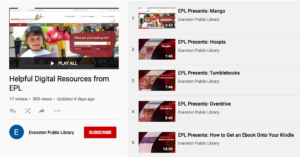One of the central debates concerning libraries at this precise moment in time is whether or not the aid and materials that we provide should be considered an “essential service”. We know that we are essential in the broader sense of the term, but does that mean replicating Chicago Public Library’s formula and opening up completely in June or in safe, strategic phases? When our patrons tell us they need our physical materials, we desperately want to hand them over. Unfortunately, unlike a Starbucks or a grocery store (or even a bookstore) we differ in a single, significant way: Our materials come back to us. That means we need to find safe ways to handle materials going out and materials coming in.
But while we’ve been sequestered to our homes we haven’t been bored. In fact, many our librarians have been overwhelmingly busy! Alongside aid and e-materials, projects that we never had time for before are finally coming to fruition. Amongst them, a challenge to introduce our patrons to the massive array of resources we have available.
It’s probably no secret to you that libraries go out of their way to find the best services for their patrons. Our problem isn’t this acquisition. It’s letting you know about what we have after we’ve acquired the products. And sure, I could write a blog post a day on our cool offerings, but would you really pay attention? Do you actually want to read me every single day? Isn’t there a better method of conveying this information?
The solution, as we see it, is simple: Tutorial Videos. Here’s how it works. Here at the library we have a pretty nifty YouTube channel. And, like many places, we’ve had our children’s librarians contribute to our Songs and Stories playlist, where they do picture book readalouds, hand rhymes, songs, and more. This pairs nicely with the Nursery Rhyme Time playlist we already had up and running before. Now, since the birth of the pandemic, we have created three entirely different playlists. They are:
The purpose of these playlists is simple. Each one contains at least a dozen videos dedicated to informing the public about, amongst other things, our library’s databases, tutorials on using our ebook sites, methods of using common programs like Yahoo or Windows for Spanish speaking patrons, etc.
The tutorials are a new venture at our library. Their construction is simple. Staff members select a database or ebook program and then create a kind of online how-to guide on what it is and how to use it. The first video was filmed partially before the shutdown and explains how to use a language learning program called Mango:
That video, which premiered on March 17th, right after the shutdown, has already garnered more than 300 views (not too shabby when you consider that our YouTube channel has only 240 subscribers).
After a tutorial is produced, each one is then translated into Spanish and placed on the Spanish YouTube playlist channel. Here, for example, is the Spanish language version of the Mango video. The introductory portion was cut out, and the library website translated to Spanish in the background. Additionally, we changed the text of the tutorial so that it was more pertinent to the needs of Spanish language speakers:
Now back in the day when I attended library school (this would be roughly 20 years ago) they didn’t offer a class in editing online tutorials. A lot of the work has been a case of learning on the job. That said, there is so much a person can do from home these days without a lot of fancy equipment. Thanks to my own podcast, for example, I had access to public domain music for each video’s intro and outro. I’d done enough work with iMovie over the years that I had a passing familiarity with transitions, and simple things like splitting the clips. Naturally, as I don’t speak Spanish, one of the most difficult jobs has been queuing up the videos to match the new Spanish audio files. To help me, the people making the translations will send me Word documents of the text. Using that I can stumble through the audio files and line everything up so that it matches.
Different staff members have different levels of comfort with this kind of work. Some will do everything from the script to the audio recording to recording their screens and editing everything together. Others might write the script and record their voices but leave the screen recording to me. Still others have found that they can create PowerPoints of their presentations, and send me the files that should accompany each slide. Whatever the case, the hope is that I can slap the same opening and closing music and visual so that there’s a continuity to the video series.
Here’s what a PowerPoint video tutorial can look like:
Rather than alert the public to every new video we produce (at the current rate of production we’re averaging about 3-5 new video content a week), links to each tutorial are placed alongside the name of its database or program on the library’s resources page. In doing so, we attempt to not date our audio files with mentions of COVID-19 or anything else that might make them less pertinent in the future. Our hope is that these videos last long beyond our current pandemic.
With each video we learn more and more ways to troubleshoot our issues. Our hope is that by the time these unprecedented times are done, we will have a complete video playlist of unique videos that help all our patrons, no matter whom they might be, find precisely whatever it is that they’re looking for. Even if they didn’t know they wanted it yet.

